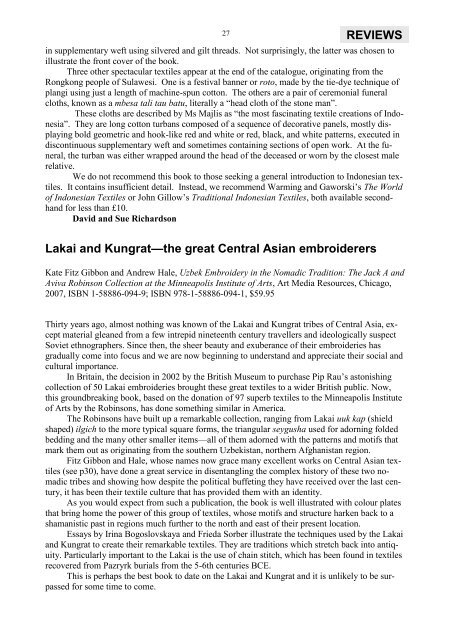Download - OATG. Oxford Asian Textile Group
Download - OATG. Oxford Asian Textile Group
Download - OATG. Oxford Asian Textile Group
Create successful ePaper yourself
Turn your PDF publications into a flip-book with our unique Google optimized e-Paper software.
27<br />
REVIEWS<br />
in supplementary weft using silvered and gilt threads. Not surprisingly, the latter was chosen to<br />
illustrate the front cover of the book.<br />
Three other spectacular textiles appear at the end of the catalogue, originating from the<br />
Rongkong people of Sulawesi. One is a festival banner or roto, made by the tie-dye technique of<br />
plangi using just a length of machine-spun cotton. The others are a pair of ceremonial funeral<br />
cloths, known as a mbesa tali tau batu, literally a ―head cloth of the stone man‖.<br />
These cloths are described by Ms Majlis as ―the most fascinating textile creations of Indonesia‖.<br />
They are long cotton turbans composed of a sequence of decorative panels, mostly displaying<br />
bold geometric and hook-like red and white or red, black, and white patterns, executed in<br />
discontinuous supplementary weft and sometimes containing sections of open work. At the funeral,<br />
the turban was either wrapped around the head of the deceased or worn by the closest male<br />
relative.<br />
We do not recommend this book to those seeking a general introduction to Indonesian textiles.<br />
It contains insufficient detail. Instead, we recommend Warming and Gaworski‘s The World<br />
of Indonesian <strong>Textile</strong>s or John Gillow‘s Traditional Indonesian <strong>Textile</strong>s, both available secondhand<br />
for less than £10.<br />
David and Sue Richardson<br />
Lakai and Kungrat—the great Central <strong>Asian</strong> embroiderers<br />
Kate Fitz Gibbon and Andrew Hale, Uzbek Embroidery in the Nomadic Tradition: The Jack A and<br />
Aviva Robinson Collection at the Minneapolis Institute of Arts, Art Media Resources, Chicago,<br />
2007, ISBN 1-58886-094-9; ISBN 978-1-58886-094-1, $59.95<br />
Thirty years ago, almost nothing was known of the Lakai and Kungrat tribes of Central Asia, except<br />
material gleaned from a few intrepid nineteenth century travellers and ideologically suspect<br />
Soviet ethnographers. Since then, the sheer beauty and exuberance of their embroideries has<br />
gradually come into focus and we are now beginning to understand and appreciate their social and<br />
cultural importance.<br />
In Britain, the decision in 2002 by the British Museum to purchase Pip Rau‘s astonishing<br />
collection of 50 Lakai embroideries brought these great textiles to a wider British public. Now,<br />
this groundbreaking book, based on the donation of 97 superb textiles to the Minneapolis Institute<br />
of Arts by the Robinsons, has done something similar in America.<br />
The Robinsons have built up a remarkable collection, ranging from Lakai uuk kap (shield<br />
shaped) ilgich to the more typical square forms, the triangular seygusha used for adorning folded<br />
bedding and the many other smaller items—all of them adorned with the patterns and motifs that<br />
mark them out as originating from the southern Uzbekistan, northern Afghanistan region.<br />
Fitz Gibbon and Hale, whose names now grace many excellent works on Central <strong>Asian</strong> textiles<br />
(see p30), have done a great service in disentangling the complex history of these two nomadic<br />
tribes and showing how despite the political buffeting they have received over the last century,<br />
it has been their textile culture that has provided them with an identity.<br />
As you would expect from such a publication, the book is well illustrated with colour plates<br />
that bring home the power of this group of textiles, whose motifs and structure harken back to a<br />
shamanistic past in regions much further to the north and east of their present location.<br />
Essays by Irina Bogoslovskaya and Frieda Sorber illustrate the techniques used by the Lakai<br />
and Kungrat to create their remarkable textiles. They are traditions which stretch back into antiquity.<br />
Particularly important to the Lakai is the use of chain stitch, which has been found in textiles<br />
recovered from Pazryrk burials from the 5-6th centuries BCE.<br />
This is perhaps the best book to date on the Lakai and Kungrat and it is unlikely to be surpassed<br />
for some time to come.

















